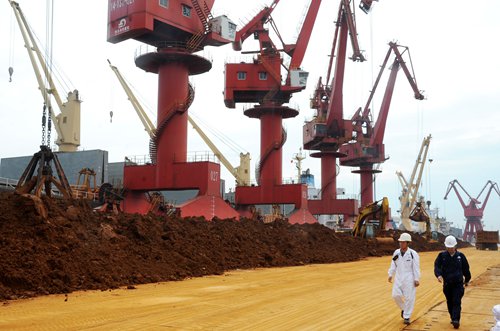China is likely to trim imports of rare earths from Myanmar starting next month, which an analyst said will help relieve oversupply in China. The country will also tighten its exports in the future because of the increasingly high environmental costs.

Chinese inspectors walk past piles of rare earth at the Port of Lianyungang in Lianyungang, East China's Jiangsu Province on May 22, 2016. Photo: IC
China imported 26,000 tons of rare earths carbonate from Myanmar in 2018, accounting for 25 percent of total domestic demand, financial news site jrj.com.cn reported Wednesday, citing an industry study. Among the imports, heavy rare earths from Myanmar accounted for about one-third of China's consumption in 2018, the report said. Amid a crackdown on illegal mining, China strengthened efforts to reduce illegal rare-earth capacity and halted approval for new mines after the end of 2016. Due to a relative domestic shortage of heavy rare earths, China increased imports from Myanmar and became a net importer of rare earths for the first time in 2018, according to the report. China is the largest producer and exporter of rare earths in the world, but because of its relative shortage of heavy rare earths, it increased imports from its neighbor, said Lin Boqiang, dean of the China Institute for Studies in Energy Policy at Xiamen University. An industry insider who preferred to be anonymous told the Global Times Wednesday that the price advantage was another factor driving China to import rare earths from the ASEAN country. It's possible that a cut in imports may be driven by concerns that illegally mined material was smuggled into Myanmar and then returned to China as imports from Myanmar. Lin stated that China is able to be self-sufficient and the industry oversupply is expected to be addressed. Imports of the minerals will be restricted in the second half of the year. Lin said that China will also tighten exports of rare earths, which is "a long-term trend" because the country aims to focus on environmental protection and "the cost to the environment from producing rare earths has become increasingly high." The mining output quota for the first half of 2019 was set at 60,000 tons, down 18.4 percent year-on-year, said a statement released by the Ministry of Industry and Information Technology and the Ministry of Natural Resources in March. It will announce the second batch of quotas by the end of June, which will "take into account market demand," read the statement.(By Huang Ge)
About CHINA MINING
Since first held in 1999, the scope and influence of CHINA MINING has grown rapidly year by year. As a global mining summit forum and exhibition, CHINA MINING Congress and Expo has become one of the world’s top mining events, and one of the world’s largest mining exploration, development and trading platforms, covering all aspects of the whole mining industry chain, including geological survey, exploration and development, mining rights trading, mining investment and financing, smelting and processing, mining techniques and equipment, mining services, etc. playing an active promotion role in creating exchange opportunities and enhancing mutual cooperation between domestic and foreign mining enterprises.
CHINA MINING Conference and Exhibition 2018 Was held at Meijiang Convention and Exhibition Center in Tianjin in October 18-20, 2018. We invite you to join the event and to celebrate the 20th anniversary of CHINA MINING with us. For more information about CHINA MINING 2018, please visit: www.chinaminingtj.org.



